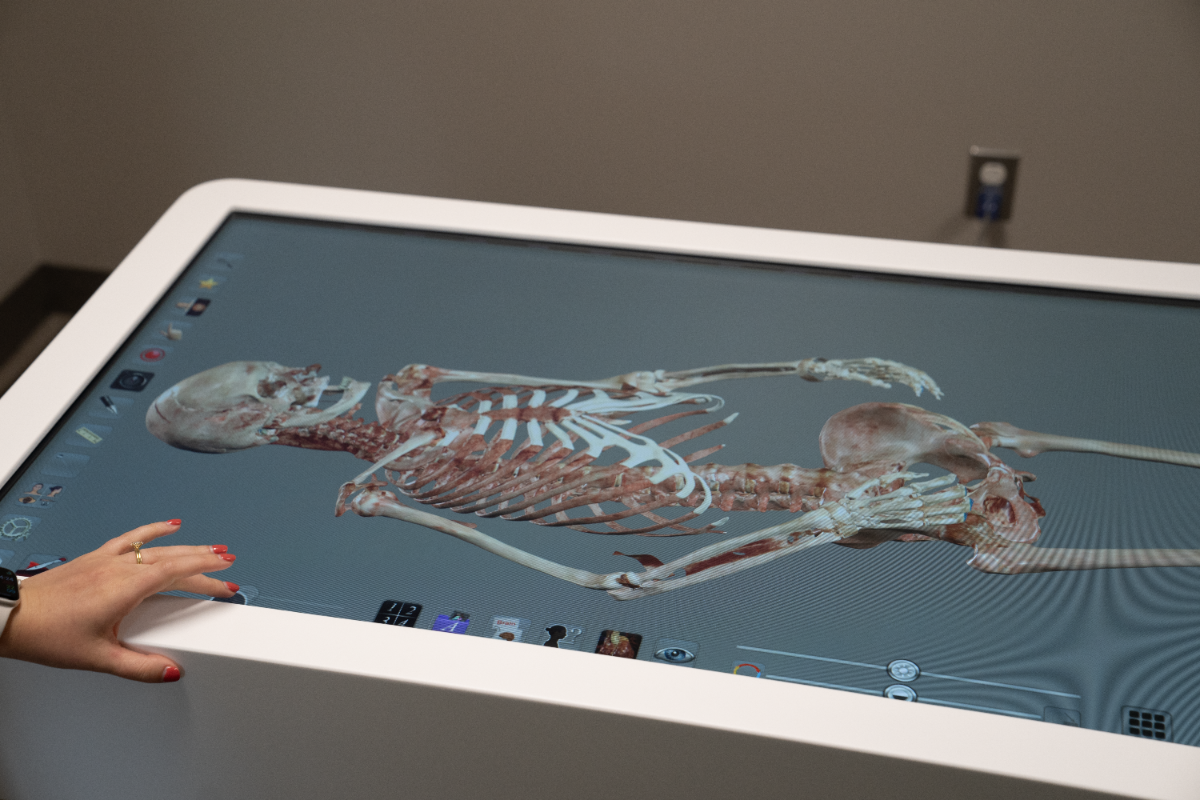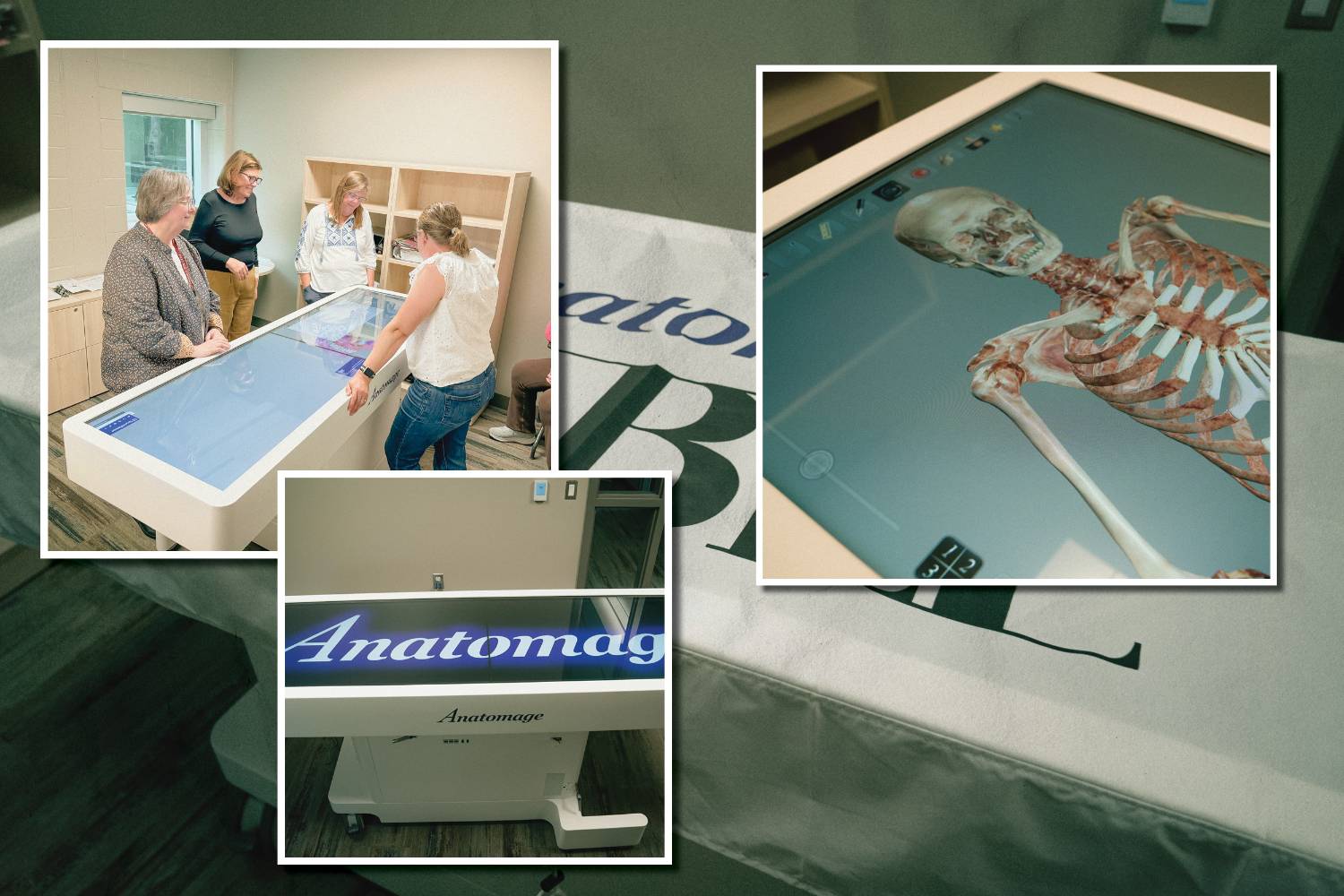A recent gift from the family of a current student has funded the purchase of an Anatomage Table, the world’s most advanced, real-human-based medical education platform.
Jay and Mary Agnes are the proud parents of AQ Saint Elizabeth Wisentaner, a current nursing student, and are passionate about enhancing the educational experience for students like her.
This gift reflects the Wisentaners’ deep commitment to the Catholic mission of Aquinas College and their desire to support the next generation of healthcare professionals. By bringing cutting-edge technology directly into the classroom, their donation will transform hands-on learning for nursing and health science students.
What is an Anatomage Table?
 An Anatomage Table is a high-tech, life-sized touchscreen used for teaching anatomy
and medical-related courses. Think of it as a virtual cadaver on a giant iPad!
An Anatomage Table is a high-tech, life-sized touchscreen used for teaching anatomy
and medical-related courses. Think of it as a virtual cadaver on a giant iPad!
Traditionally, college courses have relied on real human cadavers for instruction. Real cadavers can be expensive and hard to come by, especially for smaller schools, which means that students are often not afforded the experience of hands-on learning. Rather, they simply watch as their professor performs the exercise.
With this technology, students and faculty can explore 3D images of the human body by peeling back virtual layers of skin and muscle instead of real ones. They can even view CR and MRI scans from real people who have donated their bodies to science. It’s an incredible teaching tool, especially for programs like nursing, biology, and kinesiology.
Dr. Suzanne Keep, associate professor and director of the prelicensure program, explained that this technology will help our Saints better visualize the human body while taking Anatomy and Physiology (A&P). Additionally, classes like Health Assessment, Pathophysiology, Fundamentals, and Simulation can use the table to explore case scenarios.
“We are so fortunate to have the Anatomage table gifted to us,” states Dr. Keep. “The Anatomage table will enhance critical thinking. Students will be able to visualize healthy and diseased organs of the body. They will be able to see the heart pumping blood and then see various heart rhythms and understand what the rhythms mean. We are excited to bring the Anatomage into teaching our nursing students.”
Also looking forward to using the table for her Human A&P labs this year, Dr. Rebecca Loret De Mola, Assistant Professor of Biology, shared that this table can be more effective as a learning tool than a traditional cadaver demonstration. She explained that the table can show the case studies at different angles and zoom in to see the various bodily structures, something that isn’t easily done—or always possible—with traditional cadavers.
“Additionally,” she shared, “it allows them to 'go back' to review structures that, before, would have been removed during dissection, which will help to solidify comprehension. The myriad of applications to a student's education are vast and will enable the establishment of a rock-solid foundational understanding of human anatomy and physiology that will then serve our community as we educate future health professionals.”
Bringing the Table to Aquinas
In addition to the donors, it took a community to bring this technology to Aquinas, but the process was smooth and efficient. Abby Worthington, the executive assistant to the provost, handled the logistics, from securing the rest of the funding—courtesy of the Center for Teaching Excellence (CTE) team—to organizing the faculty training day.
As a part of the purchase, the Anatomage team provided a two-hour training session, in which faculty from the nursing, biology, and kinesiology departments joined. “The instructor actually remoted into the table to show them how it works and answered questions related to their specific courses via Zoom,” Abby shared. “It was a great hands-on learning experience. And, with the help of CTE, we were able to end the session with lunch so faculty could connect and share ideas.”
Our faculty are now fully prepared and excited to use the table when teaching their upcoming fall classes. “I am looking forward to using it in Health Assessment for focused review of cardiac, respiratory, endocrine, neurological, musculoskeletal, gastrointestinal, and urogenital systems,” shared Dr. Ivy Razmus, Associate Nursing Professor.
The table is located in Albertus Hall, room 122, and there will be a schedule where faculty may reserve it for lectures.
